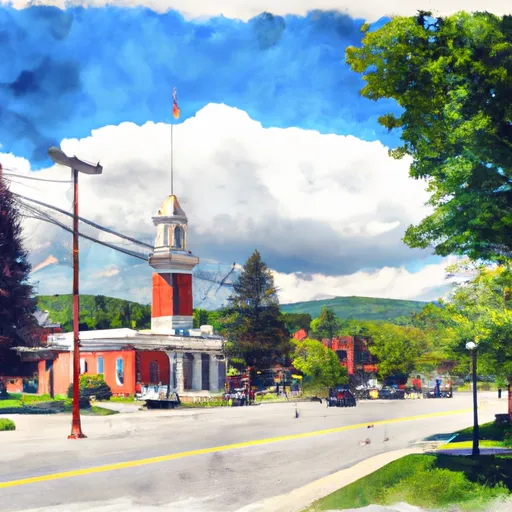-
 Snoflo Premium
Snoflo Premium
Get unlimited access to all our content
With no Ad interruptions! - Start Your Free Trial Login with existing account
Marshfield
Eden Index
Climate
7.2
•
Recreation
4.3
•
Community
0.8
•
Safeguard
4.6/10

Marshfield, Vermont is a small town located in the northeastern part of the state. Its climate is characterized by warm summers and cold winters, typical of the New England region. The average temperature in July, the warmest month, hovers around 80°F (27°C), while in January, the coldest month, temperatures can drop to around 10°F (-12°C). Snowfall is abundant during the winter months, providing opportunities for winter sports enthusiasts.
Hydrologically, Marshfield is home to several small rivers and streams, including the Winooski River and its tributaries. These water bodies contribute to the town's picturesque landscapes and provide opportunities for fishing, kayaking, and canoeing. The area is also dotted with numerous ponds, making it an ideal spot for boating and swimming during the warmer months.
Outdoor recreation opportunities in Marshfield are abundant. The town is surrounded by lush forests, offering hiking trails for nature lovers and providing opportunities for birdwatching and wildlife spotting. The Groton State Forest, located nearby, features numerous lakes and ponds, which are perfect for fishing, camping, and picnicking. Overall, Marshfield offers a serene natural environment that beckons visitors and residents to explore its diverse outdoor offerings.
What is the Eden Index?
The Snoflo Eden Index serves as a comprehensive rating system for regions, evaluating their desirability through a holistic assessment of climate health, outdoor recreation opportunities, and natural disaster risk, acknowledging the profound impact of these factors on livability and well-being.
Climate Health Indicator (CHI): 7.2
Marshfield receives approximately
1149mm of rain per year,
with humidity levels near 79%
and air temperatures averaging around
6°C.
Marshfield has a plant hardyness factor of
4, meaning
plants and agriculture in this region thrive during a short period during spring and early summer. Most
plants will die off during the colder winter months.
By considering the ideal temperature range, reliable water supplies, clean air, and stable seasonal rain or snowpacks, the Climate Health Indicator (CHI) underscores the significance of a healthy climate as the foundation for quality living.
A healthy climate is paramount for ensuring a high quality of life and livability in a region, fostering both physical well-being and environmental harmony. This can be characterized by ideal temperatures, reliable access to water supplies, clean air, and consistent seasonal rain or snowpacks.
Weather Forecast
Streamflow Conditions
Richelieu
Area Rivers
Richelieu
Snowpack Depths
Richelieu
Reservoir Storage Capacity
Richelieu
Groundwater Levels
Recreational Opportunity Index (ROI): 4.3
The Recreational Opportunity Index (ROI) recognizes the value of outdoor recreational options, such as parks, hiking trails, camping sites, and fishing spots, while acknowledging that climate plays a pivotal role in ensuring the comfort and consistency of these experiences.
Access to outdoor recreational opportunities, encompassing activities such as parks, hiking, camping, and fishing, is crucial for overall well-being, and the climate plays a pivotal role in enabling and enhancing these experiences, ensuring that individuals can engage in nature-based activities comfortably and consistently.
Camping Areas
| Campground | Campsites | Reservations | Toilets | Showers | Elevation |
|---|---|---|---|---|---|
| Storrs Pond Rec Area | 30 | 591 ft | |||
| Ricker Pond State Park | 27 | 1,118 ft | |||
| Prouty Beach Campground | 56 | 696 ft | |||
| New Discovery State Park | 47 | 1,738 ft | |||
| Elmore State Park | None | 1,637 ft | |||
| Stillwater State Park | 62 | 1,129 ft | |||
| Big Deer State Park | 23 | 1,179 ft | |||
| Eden Rec Area | None | 1,251 ft |
Nearby Ski Areas
Catastrophe Safeguard Index (CSI):
The Catastrophe Safeguard Index (CSI) recognizes that natural disaster risk, encompassing floods, fires, hurricanes, and tornadoes, can drastically affect safety and the overall appeal of an area.
The level of natural disaster risk in a region significantly affects safety and the overall livability, with climate change amplifying these risks by potentially increasing the frequency and intensity of events like floods, fires, hurricanes, and tornadoes, thereby posing substantial challenges to community resilience and well-being.
Community Resilience Indicator (CRI): 0.8
The Community Resilience Indicator (CRI) recognizes that education, healthcare, and socioeconomics are crucial to the well-being of a region. The CRI acknowledges the profound impact of these elements on residents' overall quality of life. By evaluating educational resources, healthcare accessibility, and economic inclusivity, the index captures the essential aspects that contribute to a thriving community, fostering resident satisfaction, equity, and social cohesion.

